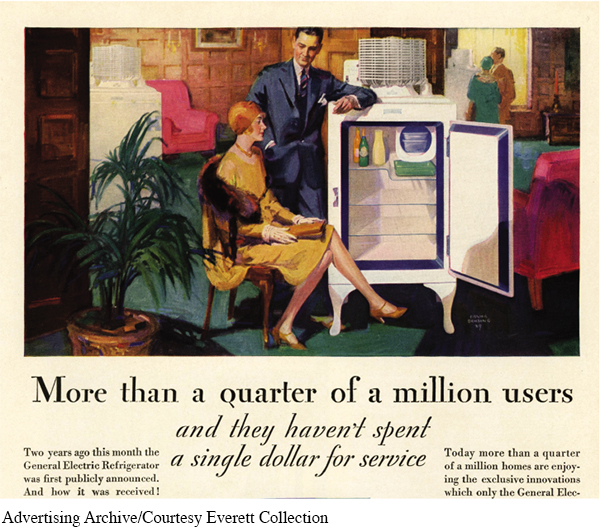Americans Become Consumers
The 1920s marked a period of economic expansion and general prosperity. National income rose from approximately $63 billion to $88 billion, and per capita income jumped from $641 to $847, an increase of 32 percent. The purchasing power of wage earners climbed approximately 20 percent.
This great spurt of economic growth in the 1920s resulted from the application of technological innovation and scientific management techniques to industrial production (Figure 21.1). Perhaps the greatest innovation came with the introduction of the assembly line. First used in the automobile industry before World War I, the assembly line moved the product to a worker who performed a specific task before sending it along to the next worker. This deceptively simple system, perfected by Henry Ford, saved enormous time and energy by emphasizing repetition, accuracy, and standardization. Streamlined production lowered costs, which, in turn, allowed Ford to lower prices.

Besides the automobile, the second industrial revolution focused on the production of consumer-oriented goods previously considered luxuries. The electrification of urban homes created demand for a wealth of new labor-saving appliances. Refrigerators, washing machines, toasters, and vacuum cleaners appealed to middle-class housewives whose husbands could afford to purchase them. Wristwatches replaced bulkier pocket watches. Radios became the chief source of home entertainment.
Although such household items changed the lives of many Americans, no single product had as profound an effect on American life in the 1920s as the automobile. Auto sales soared in the 1920s from 1.5 million to 5 million, fueling the growth of related industries such as steel, rubber, petroleum, and glass. In 1929 Ford and his competitors at General Motors, Chevrolet, and Oldsmobile employed nearly 4 million workers, and around one in eight American workers toiled in factories connected to automobile production.
The automobile also changed day-to-day living patterns. Although most roads and highways consisted of dirt and contained rocks and ruts, enough were paved to extend the boundaries of suburbs farther from the city. By the end of the 1920s, around 17 percent of Americans lived in suburbia. Cars allowed families to travel to vacation destinations at greater distances from their homes. Even the roadside landscape changed, as gas stations, diners, and motels sprang up to serve motorists. Each year, vacation resorts on the east and west coasts of Florida attracted thousands of tourists who drove south to enjoy the state’s beautiful beaches. Motorists also flocked to national parks in the Rocky Mountains and on the West Coast.
The automobile also provided new dating opportunities for young men and women. At the turn of the twentieth century, a young man courted a woman by going to her home and sitting with her on the sofa or out on the porch under the watchful eyes of her parents and family members. With the arrival of the automobile, couples could move from the couch in the parlor to the backseat of a car, away from adult supervision. Driving to a “lover’s lane,” the young couple could express their feelings with greater physicality than before.
Although Ford and his fellow manufacturers succeeded in lowering prices, they still had to convince Americans to spend their hard-earned money to purchase their products. Turning for help to the fledgling advertising industry, manufacturers nearly tripled their spending on advertising over the course of the 1920s. Firms pitched their products around price and quality, but they directed their efforts more than ever to the personal psychology of the consumer. Advertisers played on consumers’ unexpressed fears, unfulfilled desires, hopes for success, and sexual fantasies. The producers of Listerine mouthwash transformed a product previously used to disinfect hospitals into one that fought the dreaded but made-up disease of halitosis (bad breath). Advertisers told people that they could measure success through consumption. Purchasing a General Electric all-steel refrigerator not only would preserve food longer but also would enhance the owners’ reputation among their neighbors.

Although average wages and incomes rose during the 1920s, the majority of Americans did not have the disposable income to afford the bounty of new consumer goods. To resolve this problem, companies extended credit in dizzying amounts. By 1929 consumers purchased 60 percent of their cars and 80 percent of their radios and furniture on credit—mainly through the installment plan. “Buy now and pay later” became the motto of corporate America.
Exploring American HistoriesPrinted Page 692
Exploring American Histories Value EditionPrinted Page 510
Chapter Timeline